Mapping Methodism – Bedford Road Methodist New Connexion/Wesleyan Church, St Ives.
Categories Mapping Methodism0 Comments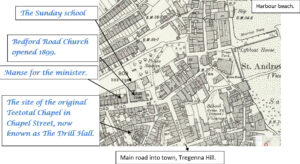
Article written by Val Thomas, St Ives Old Cornwall.
Bedford Road was built in 1899 on land originally owned by Edward Hain of The Terrace, then Treloyhan. He also owned the Manor House opposite the chapel which was in an area then called Green Court. This building had originally been owned by the Stephens family of St Ives who went on to build Tregenna Castle as their home. Bedford Road Church was built at the bottom of a new terrace of houses called Bedford Road. The chapel it was built to replace was in Chapel Street, opposite, and that building was then bought by Edward Hain and presented to the town as a Drill Hall for the Local militia. That building is still known as ‘The Drill Hall’. No one seems to know for certain who the architect for the church was but Mr Frith of Oldham was present at a meeting on April 26th 1897 at which his working plans were accepted. Mr Grenfell, the town surveyor, put in the plans for the manse which was built at the bottom of Bedford Road, next to the chapel.
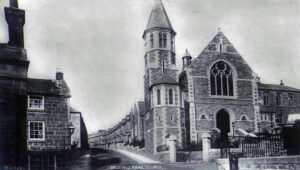 Stephens Manor House, on the front left in dark print, demolished 1905, Bedford Road Chapel built 1899. Image: Steve Prescott
Stephens Manor House, on the front left in dark print, demolished 1905, Bedford Road Chapel built 1899. Image: Steve Prescott
1898 A plot was given by Edward Hain at the bottom of the newly erected Bedford Road for a chapel, Sunday school and manse.
The contract to build was obtained by Mr J. R. Saundrey for a two coloured cut granite edifice with a large Sunday school and other rooms attached. It was built of ‘Rock-faced granite brought to course with contrasting white granite dressings, dry slate roofs, the main roofs with crested clay ridge tiles. Early and Middle Gothic style with a slight north-south projection towards the east end as a minimal cruciform plan and well-articulated west end front with porch in right-hand angle and octagonal stair turret clasping octagonal turret with spire to the left hand side. Front gable end has a large 4 light traceried window over pointed-arched doorway with ordered head. Simple interior with open roof structure end gallery and original pitch pine pews. Good coloured glass to west window. Good Gothic example.’
1898 The memorial stones were laid on June 2nd 1898. Mrs E. Hain represented her son, Edward Hain esq. J.P. The Rev Henry Faull was present. Four of the memorial stones were laid by William Faull’s children who paid 10 shillings each to symbolically tap the stone and were then given a wooden mallet as a keepsake. About 50 Sunday school scholars laid the memorial stones. There was then a procession led by St Ives brass band to Talland where they partook ‘of the cup which cheers’.
1899 April 27th – ‘The spire had just been fixed’. The church and adjoining school were opened for worship on August 3rd by Edward Hain Jnr. age 12, with a silver key to unlock the door. It seated 550 according to the plan. The minister was Samuel Wright Treasurer Edward Hain Jnr. Financial secretary: Joshua Daniel. Secretaries: Lander E. Comley + William Faull.

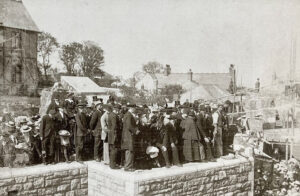 Images of Memorial stones being laid from Brian and Margaret Stevens.
Images of Memorial stones being laid from Brian and Margaret Stevens.

 Image: west-penwith.org.uk
Image: west-penwith.org.uk
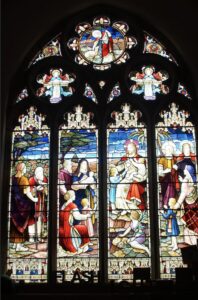 This magnificent window, in memory of Grace Hain, is at the east end and was commissioned by her father, Edward Hain. It was made by a prominent London glass artist, A. L. Moore.
This magnificent window, in memory of Grace Hain, is at the east end and was commissioned by her father, Edward Hain. It was made by a prominent London glass artist, A. L. Moore.
Along the bottom is written: “To the glory of God and in loving remembrance of Grace, eldest daughter of Edward and Catherine Hain”. She died in 1899.
Her father had just been elected Mayor of St Ives for the 6th time. Edward Hain Jnr. unveiled the window at the opening ceremony on behalf of his sister, Miss Kitty Hain, age 2.
William Faull’s family pew was under the window given in memory of Grandma Faull’s brother, while her pew was under the window she donated in memory of her husband Henry.
Next to the new church was a double fronted manse erected as the minister’s home.
William Faull was a trustee of the new church and greatly involved with its construction.
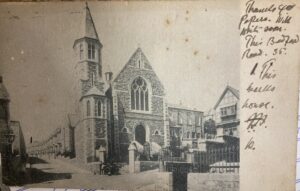 Image: Steve Prescott. To the right of the chapel is the entrance into Trewyn Gardens. Looking up Bedford Road, the manse was behind the church with the Sunday school on the right. The gate is still there in 2024 but not the railings.
Image: Steve Prescott. To the right of the chapel is the entrance into Trewyn Gardens. Looking up Bedford Road, the manse was behind the church with the Sunday school on the right. The gate is still there in 2024 but not the railings.
1908 ‘The Bedford Road United Methodist Church (Bedford Road) has recently undergone a thorough renovation. The interior has been tastefully decorated in soft green with stencil ornamental work above the dado rail and round the ceiling panels; the organ pipes have also been decorated in coloured stencil, the lettering – “Praise waiteth for Thee, O God, in Zion”, which extends over the archway – being beautifully executed.” The work was carried out by Messers Waring and Gillow, the well known designers and decorators of Oxford Street, London. The pitch pine choir screen was also replaced by a more substantial one of oak, additional sidelights were placed in the recesses either side of the sacred building, the heating arrangements were extended, the whole of the interior re-varnished, and other minor improvements made. Mr Hain kindly offered to defray the expenses incurred in the renovation. (The St Ives Weekly summary, July 4 1908).
1911 The Bedford Road organ was re-opened in March. The instrument had been unused for a month while being cleaned, re-wired and a few minor alterations made by Messers T. W. Spraggs and Sons organ builders of St Austell.
1923 The Rev A. J. Parker closed his mission at Bedford Road United Methodist Church. There were over 250 converts! (The Cornishman and Cornish Telegraph Weds 21st March 1823)
1932 Rev. A Marsden came to St Ives taking charge of Bedford Road, St Peter’s Street and Chyangweal churches. He left in 1944 and during his 12 years Bedford Road was thoroughly renovated and the organ rebuilt. He was invited to give an address in the Parish Church a few days after the St. Ives lifeboat disaster in 1939. That was the first time that a Nonconformist minister had spoken from the parish church pulpit. (The Cornishman, Thursday August 24th 1944)
1933 Became Bedford Road Methodist Church.
1990 The St Ives Infants School again held their Nativity Play in the Church.
1995 Although a strictly teetotal congregation when first built, it later became part of the Wesley circuit. In 1995 the Wesley circuit and Bedford Road merged to form the United Methodist Church.
The site of the Bedford church was split and the Sunday school sold off. It has now been made into flats. The interior of the chapel has been totally changed. The church obtained a grant of £10.000 by the Rural Development Commission towards the cost of providing community facilities at Bedford Road United Church in St Ives. The scheme, designed by Poynton, Bradbury Wynter Architects was built by John Nicholls Builders. It included a meeting room, kitchen and full disabled access and toilets. Rev. Steven Wild was the minister at the time. A new slate roof was also included in the scheme. The Bethlehem stone brought back from the Holy Land by Sir Edward Hain was placed in the foyer. (Thursday August 31st 1995).
 The old Sunday school entrance as remembered by the congregation and children of St Ives. This building has now been turned into residential flats.
The old Sunday school entrance as remembered by the congregation and children of St Ives. This building has now been turned into residential flats.
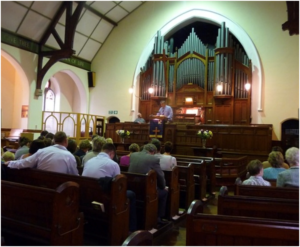
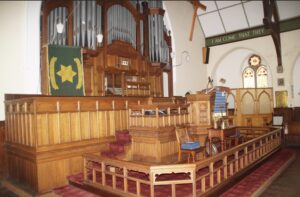 Image: Frank Stevens May 2023
Image: Frank Stevens May 2023
 The organ. Image: Frank Stevens
The organ. Image: Frank Stevens
The first organist was Miss R. Rosewarne, who was soon replaced by Mr James Luke Jacobs who was organist for many years.
The last organist of Bedford Road Church was Mr Frank Stevens.
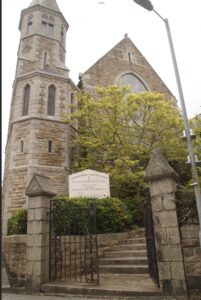 Image taken by Frank Stevens 2023.
Image taken by Frank Stevens 2023.
2023 The church was suddenly closed while still home for a local youth group. The cost of essential maintenance was the reason given for the closure. It has now been purchased by St Ives Land Trust in order to constrict housing for local people within it.
Kresen Kernow holds many records for this church and also St Peter’s Street Chapel, which was the Bible Christian chapel.
The roof from an article by Brian Stevens – 28th February 2024.
Firstly: I think Grenfell is way out with the seating capacity of this former Chapel. I would surmise it to be around 600?
Secondly: Mr. Arthur Law was the husband of Kitty Stevens and they were many years in Africa before returning to St. Ives. He contributed weather reports for a number of years that were published weekly in the ‘Echo.’
I can relate to you the story of the large principles of the roof that are to be detected within its interior. When the construction of the chapel was in progress, Mr. Saundry consulted with his carpenters about the cutting out of those main roof support timbers. He did not have much joy from them as they did, or would not, undertake such a formable task of work. Therefore Mr. Saundry asked a local shipwright to undertake the work. This was my great grandfather by name of Humphrey Honey Broad. As it was a big job for just one Shipwright, he might have had another such Shipwright with him, perhaps it was his eldest
son Humphrey H. Junior. His other son Willie Honey Broad, aged then about 16 years of age being my grandfather, was at this time learning the trade of Shipwright but do not know who with. Perhaps someone over the years might have taken photos of the interior timbers of the roof, or if perhaps the ‘Land Trust’ has an open day, then that might provide an opportunity to take some. Whenever I have been in the Chapel, I always was in awe of the size of those timber frames and would naturally congratulate my great grandfather on his workmanship. After all, for him it was just another job so similar to sawing and working with the adze to form the curvatures of the frames of a vessel. That was however executed on terrifirma, but there in that chapel building he was high up on scaffolding.
Awaiting image
Chapel China
Over the years there have been over 600 Methodist places of worship in Cornwall and many had what is known as ‘Chapel China’: some with the chapel name on them and some without. Chapels, Sunday schools and societies had frequent tea parties and on such occasions as harvest festivals and anniversaries refreshment would be served. Thus their china was used and hand washed many times so it is remarkable that names are still clear and unspoilt. Sometimes this china was purchased from chapel funds, sometimes it was plain with a clover leaf in the middle given by members, and occasionally given by a family as a gift.
Chapel china images: Steve Prescott. Text above adapted from – ‘Chapel China’ F. J. Lennox
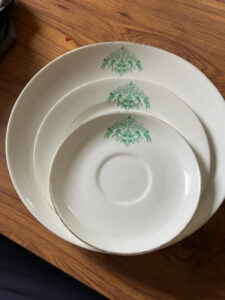
The organ from: ‘Their Sound Has Gone Out Into All The Land’. Churches, Chapels and Organs of St Ives. David Allan & Charles Nicholls
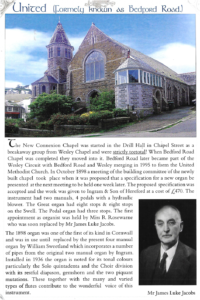
References:
Mary Quick
‘Find My Past’ for newspaper articles
Local Facebook sites
Frank and Angela Stevens
Brian Stevens
‘Their Sound Has Gone Out Into All The Land’. Churches, Chapels and Organs of St Ives. David Allan & Charles Nicholls.
St Ives Archive
Chapel China, F. J. Lennox Green
Steve Prescott
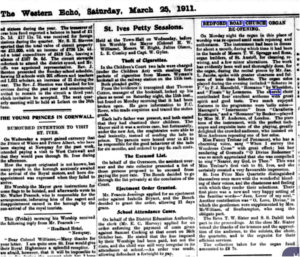
 Cornishman and Cornish Telegraph 3rd September 1936
Cornishman and Cornish Telegraph 3rd September 1936
